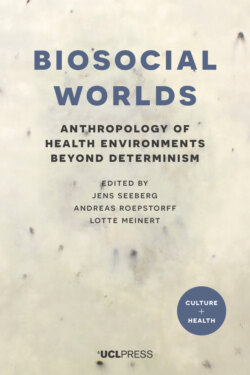Читать книгу Biosocial Worlds - Группа авторов - Страница 18
На сайте Литреса книга снята с продажи.
Behavioural epigenetics
ОглавлениеIn what follows, I first set out the surprising findings that emerged when mapping the human genome. These discoveries encouraged a burgeoning of research in the field known today as ‘behavioural epigenetics’, a discipline anchored by the impact of environmental variables external and internal to the body on human development throughout the life course, from the moment of conception on. The idea of ‘environment’ is apparently self-evident, so much so that Raymond Williams gave it no entry in Keywords (Williams 1983), although he describes nature, often associated with environment, as ‘perhaps the most complex word in the English language’. According to the Oxford English Dictionary, the earliest definition of the word ‘environment’ appears in the mid-eighteenth century as ‘that which environs’ and also as ‘the objects or the region that surrounds anything’ (Oxford English Dictionary). Contemporary dictionaries include the following meanings: ‘The aggregate of surrounding things, conditions, or influences; milieu, the air, water, minerals, organisms, and all other external factors surrounding and affecting a given organism at any time and, further, the social and cultural forces that shape the life of a person or a population.’ Clearly, if the notion of environment is central to any given scientific endeavour, it requires delineation, demarcation and/or contouring at the outset.
Epigenetics is being heralded as a scientific discipline that may well transcend the reductionism associated with many investigations carried out in the field of molecular genetics. However, several social scientists have expressed concern about the apparent neo-reductionism evident in the majority of projects currently being conducted under the umbrella of environmental epigenetics (Lock 2013a, 2013b; Niewöhner 2011; Richardson 2015). Several of the illustrative examples presented in this paper make it clear that a tendency exists on the part of epigeneticists to systematically scale down and miniaturise what is delineated as environment in their research projects. This practice enables standardisation of methodologies, and makes it possible to carry out all-important replication studies. The result is that economic and socio-political variables that contribute in profound ways to health and illness are set to one side. This is in no way to deny the importance of the molecularlised findings as such, but to suggest that if the implications of these rich insights emerging in epigenetics are to be fully grasped, then limiting accounts to the effects of proximate variables on human bodies falls short.
Epigenetics is slowly exposing certain of the molecular pathways both external and internal to the body by means of which depredating situations literally transform individual genomes; findings such as these are regarded by many scientists and non-scientists as ‘hard’ data, tout court, and such molecular profiles will almost certainly become the first line of evidence to assist in decision making in the courts and by policy makers in connection with neglect, abuse and other forms of violence. The cases discussed below make clear how important it is that documentation of bodily epigenetic changes not be limited to proximate variables. On the contrary, when it comes to medical care, policy making and legal cases, economic and socio-political variables that impact on everyday life that have clearly contributed to the situation should be included. In addition, narratives given by affected individuals furnish invaluable data.
The field of epigenetics is young, and many research findings are at present provisional. Even so, this burgeoning specialty has the potential to bring about a paradigm shift that has already transformed the world of genomics to a considerable extent. Similarly, the fields of epidemiology and public health are undergoing a seismic shift in thinking about nosologies of ill health and early death: the effects of poverty, violence and low levels of education that have long been researched by epidemiologists and public health practitioners can now be linked directly to epigenetic changes that affect brain development and functioning throughout life. Moreover, it is increasingly clear that even if such epigenetic changes are not transmitted intergenerationally they are all too often produced anew in ensuing generations if the social conditions are not changed. Media reporting and social media make it clear that clinicians and the public at large are processing this information, although not always with the required accuracy and precaution that is needed.
